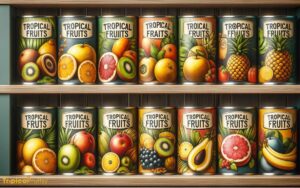Is Dragon Fruit a Tropical Fruit? Yes!
Yes, dragon fruit is considered a tropical fruit. It is native to the Americas but is now grown in various tropical and subtropical regions around the world.
Dragon fruit, also known as pitaya, is a tropical fruit known for its vibrant skin and unique, sweet taste. Tropical fruits are those that grow naturally in the tropics, the region of Earth surrounding the equator.
These fruits typically require warm temperatures and a certain level of humidity to thrive, conditions that are met in regions such as Southeast Asia, parts of South America, and other similar climates.
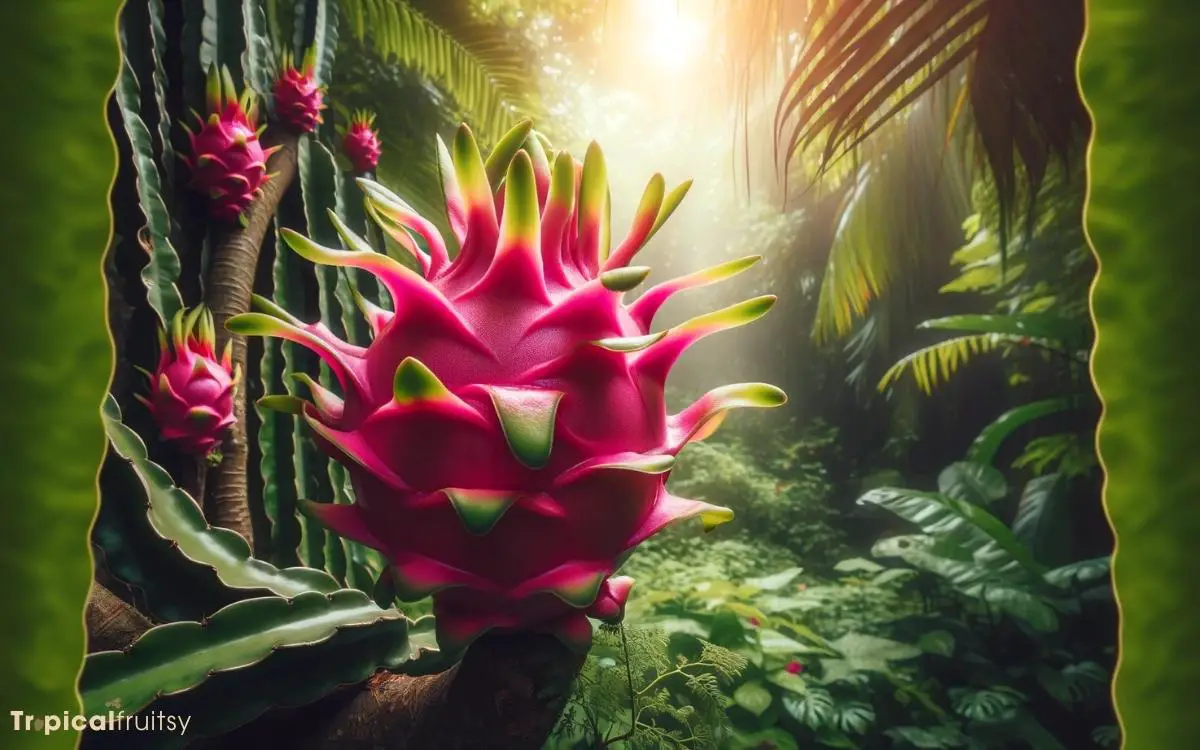
Key Takeaway
Unveiling the Dragon Fruit

The dragon fruit’s distinctive appearance, with its vibrant pink skin and speckled flesh, belies its origins in tropical climates.
Botanically known as Hylocereus undatus, this cactus species thrives in warm, humid environments and is native to regions in Central America. It has since been cultivated globally in areas with suitable growing conditions.
Dragon fruit’s growth cycle is unique among cacti, as it flowers only at night, relying on nocturnal pollinators such as bats and moths. The fruit itself is a rich source of antioxidants, vitamin C, and dietary fiber.
Its cultivation requires careful management of soil conditions, temperature, and moisture levels to ensure successful pollination and fruit set, underscoring its tropical adaptation and agricultural requirements.
Defining Tropical Fruits
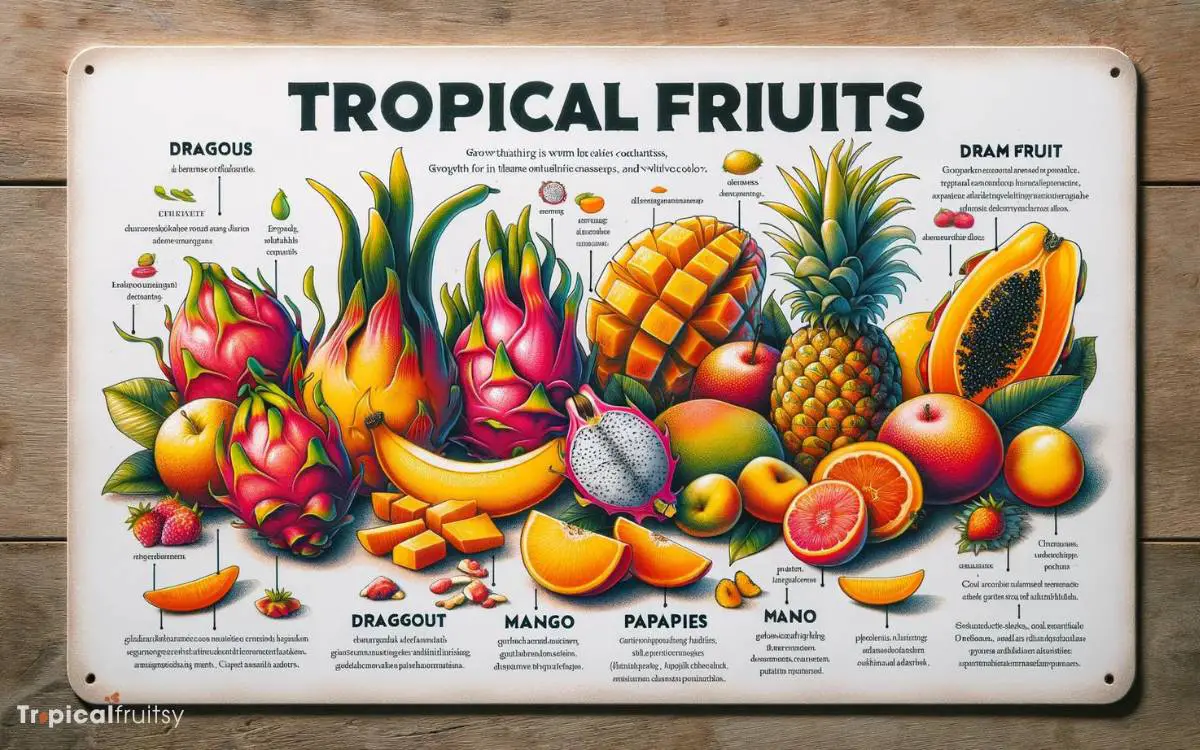
Tropical fruits, typically hailing from regions between the Tropic of Cancer and the Tropic of Capricorn, encompass a diverse group of plants that flourish in warm, humid climates similar to the dragon fruit’s native habitat.
Characterized by their necessity for frost-free environments, these fruits often require a consistent temperature range, ample rainfall, and specific soil conditions to thrive.
Many tropical fruits, including mangoes, papayas, and pineapples, have adapted to these equatorial zones, developing unique physiological traits such as thick skins to prevent moisture loss and bright colors to attract pollinators.
The cultivation of these fruits is vital to both local economies and global markets, where they are prized for their exotic flavors and nutritional benefits.
Understanding the ecological requirements of tropical fruits leads us to explore the specific conditions of the dragon fruit’s native habitat.
Dragon Fruit’s Native Habitat

Originally from Central America, dragon fruit commonly grows in regions with warm, moist climates that are typical of tropical environments.
This cactus species, known scientifically as Hylocereus undatus, thrives in areas where temperatures are consistently moderate to high and rainfall is abundant.
The plant’s native habitat provides it with the ideal conditions for growth and fruit production.
To further understand the specific environmental conditions dragon fruit requires, consider the following table:
| Climate Factor | Ideal Condition for Dragon Fruit |
|---|---|
| Temperature | 20-30°C (68-86°F) |
| Rainfall | 600-1300 mm annually |
| Humidity | 50-70% |
| Soil Type | Well-drained, sandy loam |
| pH Level | 6.0-7.0 |
These parameters are critical for the cultivation of dragon fruit and are characteristic of its native tropical habitat. Understanding these conditions is essential for successful cultivation outside its native range.
Cultivation and Climate Needs
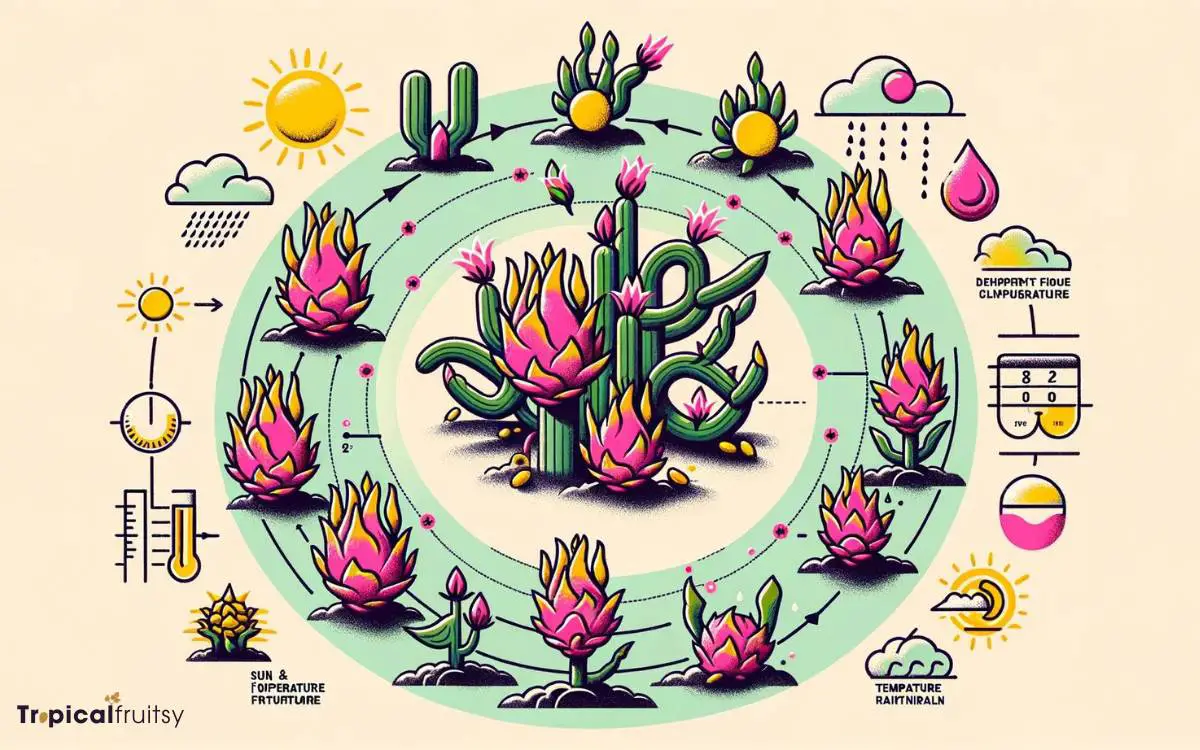
Dragon fruit, or pitaya, thrives under specific climatic conditions that are essential to consider for successful cultivation.
The plant requires an optimal growth temperature range of 20 to 30 degrees Celsius, ensuring adequate warmth for development and fruiting.
In terms of soil, it shows a preference for well-draining loam with high organic matter content, maintaining a pH between 5.5 to 7, to support its root systems and maximize nutrient uptake.
Optimal Growth Temperature
We must consider that dragon fruit thrives best in temperatures ranging from 21 to 29 degrees Celsius (70 to 85 degrees Fahrenheit), highlighting its affinity for warm and humid climates.
The thermophilic nature of dragon fruit plants necessitates a stable thermal environment to facilitate optimal physiological processes, including photosynthesis, fruit set, and maturation.
Prolonged exposure to temperatures below 10 degrees Celsius (50 degrees Fahrenheit) can lead to chilling injuries, while excessive heat above 40 degrees Celsius (104 degrees Fahrenheit) may cause heat stress and impair pollination.
Therefore, cultivators must ensure a controlled microclimate, often employing shading techniques and irrigation systems to mitigate temperature fluctuations.
This precise temperature management underscores the plant’s selective habitat preferences, seamlessly leading to the discussion of another crucial aspect: soil type preference.
Soil Type Preference
In addition to its specific thermal requirements, the cultivation of dragon fruit demands well-draining soil with a slightly acidic to neutral pH, typically between 6 and 7, to support its tropical origin and ensure robust growth.
This cactus species thrives in soils that facilitate aeration and prevent water-logging, which can lead to root rot and other fungal diseases.
While it can tolerate some variations in soil composition, adherence to these parameters promotes optimal nutrient uptake and plant health.
| Soil Characteristic | Ideal Condition |
|---|---|
| Drainage | Well-draining |
| pH Level | Slightly acidic to neutral (6-7) |
| Texture | Sandy loam or loam |
| Organic Content | Moderate to high |
| Salinity | Low |
These soil conditions combined with the appropriate climatic environment contribute significantly to the successful cultivation of dragon fruit.
Global Distribution of Dragon Fruit
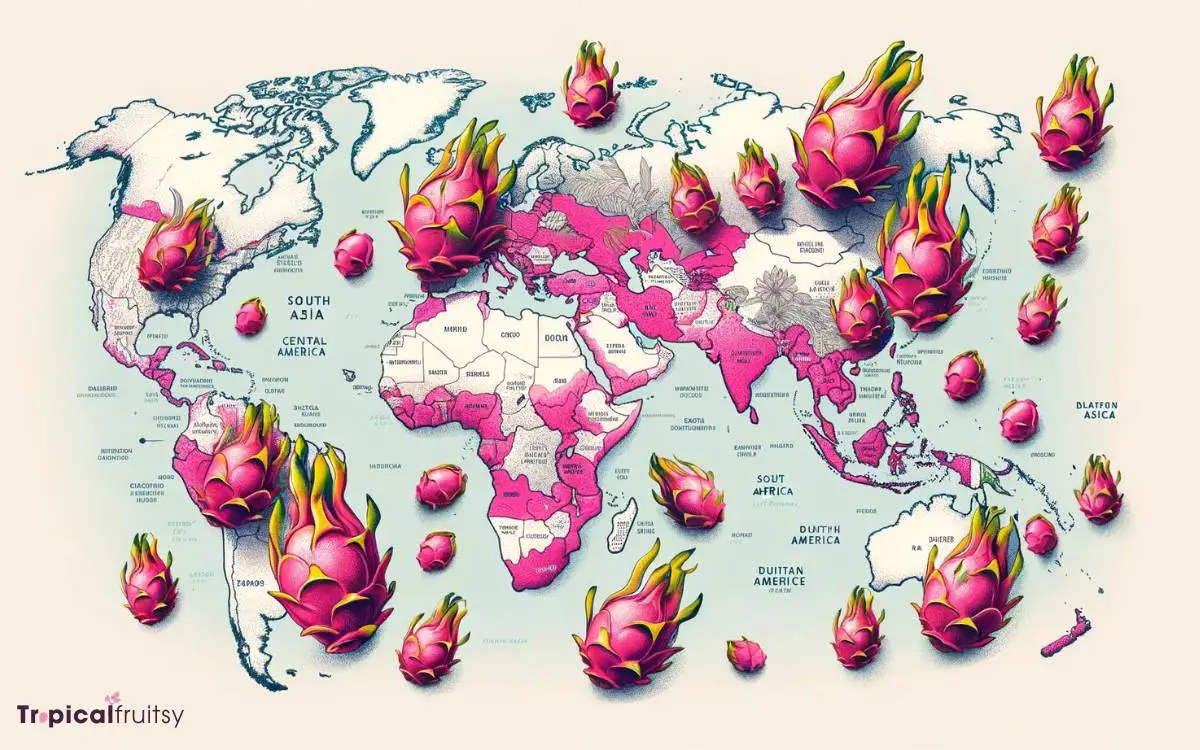
Dragon fruit, scientifically known as Hylocereus undatus, has witnessed a notable expansion in its global distribution, primarily thriving in regions with a conducive tropical and subtropical climate.
The main growing regions include countries within Southeast Asia, Central and South America, and select locales in the United States, where the climatic conditions align with the fruit’s requirements for temperature and humidity.
As a result, nations like Vietnam, Thailand, and Colombia have emerged as leading exporters, contributing significantly to the international trade of this exotic fruit.
Main Growing Regions
As a tropical cactus species, dragon fruit primarily thrives in warm and humid regions, with Vietnam, Thailand, and the Philippines being leading producers globally.
These countries offer ideal climatic conditions for dragon fruit cultivation, which demands high temperatures and significant humidity levels for optimal growth and fruit development.
The precise agricultural practices and the extensive knowledge of local farmers contribute to the high yield and quality of the dragon fruit produced in these regions.
Vietnam:
- Largest exporter: Dominates the international market.
- Innovative farming techniques: Enhances quality and increases yield.
Thailand:
- Diverse varieties: Specializes in different types of dragon fruit.
- Sustainable practices: Focus on eco-friendly cultivation methods.
Philippines:
- Expansion efforts: Government and private sector initiatives to increase production.
- Research and development: Improving crop resilience and fruit quality.
Exporting Countries
Having established themselves as prime growers, Vietnam, Thailand, and the Philippines also lead in the global distribution of dragon fruit, with Vietnam being the top exporter.
Vietnam’s prominence in the market is attributed to its favorable climate, efficient farming practices, and strategic investments in agricultural technology, which have optimized yield and fruit quality.
The nation’s export strategy focuses on compliance with international standards, ensuring that the product meets the rigorous quality and safety criteria of importing countries.
As a result, Vietnam has carved out significant market shares in the United States, European Union, and China.
Thailand and the Philippines follow suit, capitalizing on their robust agricultural sectors to distribute dragon fruit globally, albeit with smaller volumes compared to Vietnam.
These countries have adapted their export logistics to maintain fruit integrity during transit, ensuring delivery of fresh, high-quality dragon fruit to international markets.
What Qualifies a Fruit to Be Considered Tropical?
Tropical fruits are typically grown in warm climates near the equator, including bananas, pineapples, and mangoes. A fruit can be considered tropical if it thrives in a hot, humid environment. However, despite its common misconception, the tomato isn’t a tropical fruit. It can still grow in tropical climates, but it’s not considered a tropical fruit.
Verdict: Tropical or Not?
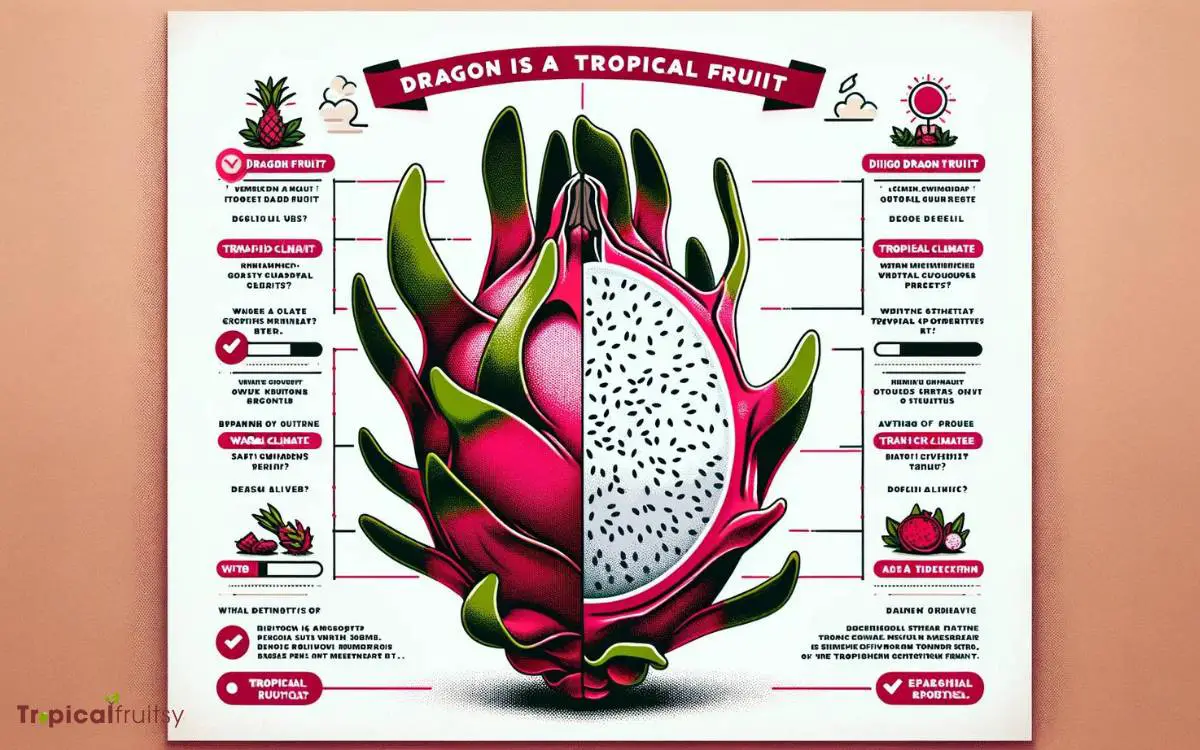
Upon thorough examination of its growth requirements and native habitat, it is evident that dragon fruit qualifies unequivocally as a tropical fruit.
This classification is substantiated by several botanic and climatic criteria:
Growth Requirements:
- Thrives in temperatures between 20°C to 30°C (68°F to 86°F)
- Requires high humidity, typical of tropical climates
Native Habitat:
- Indigenous to regions in Central America
- Flourishes in areas with a tropical climate, marked by minimal temperature variation
These factors, intrinsic to the dragon fruit’s successful cultivation, align with the defining characteristics of tropical fruits.
Consequently, the dragon fruit is not just compatible with, but dependent on a tropical environment for its optimal growth, leading to the irrefutable conclusion of its tropical fruit status.
Conclusion
The dragon fruit, with its native roots anchored in the tropical climates of Central America, unequivocally falls within the category of tropical fruits.
Its cultivation preferences for warm temperatures and high humidity mirror the quintessential characteristics of tropical regions. The widespread cultivation across various tropical climates globally reinforces its classification.
Therefore, the dragon fruit’s alignment with the ecological and botanical criteria for tropical fruits is both scientifically substantiated and agronomically observed.



